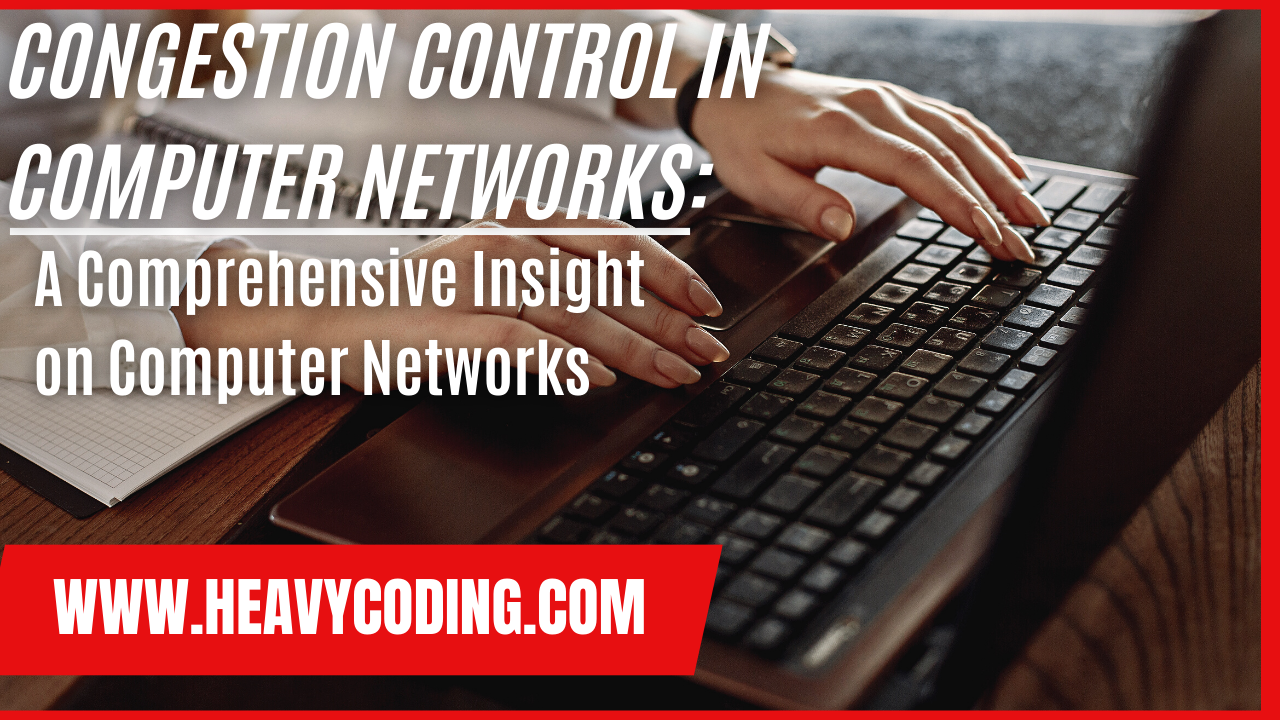In the current digital landscape, computer networks play a crucial role in facilitating the transmission of data and information. However, as networks become more complex and the amount of data increases, congestion issues arise. Congestion can have a significant impact on network performance, resulting in delays, packet loss, and a diminished user experience. In this article, we will examine the concept of congestion control in computer networks, as well as the techniques and strategies used to mitigate congestion.
Table of Contents
Looking for comprehensive study materials on Python, Data Structures and Algorithms (DSA), Object-Oriented Programming (OOPs), Java, Software Testing, and more?
Introduction to Congestion Control in Computer Networks
A fundamental aspect of network administration, congestion control seeks to regulate and optimize the data flow within a network. Monitoring network conditions, identifying congested areas, and implementing the appropriate measures to alleviate congestion in order to maintain network efficiency.
Understanding Congestion in Computer Networks
When the demand for network resources exceeds their available capacity, congestion occurs. This may occur due to excessive data traffic, limited bandwidth, network bottlenecks, or ineffective routing algorithms. Congestion degrades network performance, resulting in an increase in latency, packet loss, and a decrease in transmission.
Causes and Effects of Congestion
Causes of Congestion:
- Network Overload: When there is excessive demand on the network infrastructure, such as during peak hours or an abrupt surge in traffic, congestion can occur.
- Bandwidth Limitations: Insufficient network bandwidth to support the volume of traffic can result in congestion. This can occur when the available bandwidth is insufficient to transmit the data.
- Network Equipment Issues: Congestion can also occur as a result of limitations or malfunctions in network infrastructure, such as routers or switches. Congestion can occur if these devices cannot manage the incoming traffic efficiently.
- Network Topology: The network’s architecture and design can contribute to congestion. A network with constraints or a singular point of failure, for instance, may be more prone to congestion.
Effects of Congestion:
Increased Latency: Congestion can cause delays in the transmission of data packets across the network. As more traffic competes for limited resources, user latency or delay increases, resulting in delayed response times.
Packet Loss: When network congestion reaches a critical level, the network may begin to lose packets to relieve the overburden. Loss of packets can have a substantial effect on the efficacy of network services, especially for real-time applications such as voice or video broadcasting.
Reduced Throughput: As the available bandwidth is divided among competing fluxes, congestion can reduce the overall throughput of the network. This may result in reduced data transfer rates and decreased user efficacy.
Instability of the Network: Severe congestion can result in network instability and even network failures. If congestion is not adequately managed, it can result in cascading effects that compromise the network’s stability and dependability.
Congestion Control Mechanisms
In computer networks, congestion control mechanisms are techniques and algorithms used to govern and regulate network traffic in order to prevent congestion and maintain optimal network performance. These mechanisms are designed to prevent the overloading of network resources, such as bandwidth, and to guarantee the equitable and efficient use of available capacity. Here are some typical congestion control strategies:
Traffic Shaping: Traffic shaping involves regulating the rate at which network packets are transmitted in order to level out traffic spikes. It controls the transmission rate by buffering and delaying packets, thereby limiting their flux. Traffic shaping helps prevent congestion by preventing sudden increases in network utilization.
Quality of Service (QoS): Quality of Service (QoS) mechanisms give certain forms of network traffic precedence over others based on predefined rules or policies. By designating various levels of priority to different traffic flows, QoS ensures that time-sensitive or mission-critical applications receive preferential treatment, thereby reducing the likelihood of congestion for these vital flows.
Congestion Avoidance: Avoiding Congestion Algorithms for avoiding congestion is typically implemented in transport layer protocols, such as TCP (Transmission Control Protocol). These algorithms monitor the network for indicators of congestion, including packet loss and increased latency, and modify the transmission rate accordingly. TCP’s congestion control mechanisms, including TCP Reno and TCP Vegas, are examples of congestion avoidance algorithms that dynamically regulate data flow to prevent network saturation.
Traffic Engineering: Traffic engineering techniques optimize the routing and distribution of network traffic in order to prevent congestion and optimize network performance. This can be accomplished by dynamically modifying the paths network traffic takes, redistributing network resources, or using load-balancing techniques to distribute traffic evenly across multiple network connections.
Admission Control: Admission control mechanisms prevent the network from accepting more traffic than it can manage without causing congestion. Before allowing new connections or transfers, the network evaluates its current state and available resources to determine if it can accommodate the additional traffic. If the network is already congested or nearing its capacity, admittance control may deny new requests to prevent the congestion from worsening.
Explicit Congestion Notification (ECN): ECN is a mechanism that enables network devices, like routers, to notify the source of congestion without discarding packets. ECN designates packets to signify congestion along the network path, rather than relying solely on packet loss as an indicator of congestion. In response to these congestion notifications, the source can then reduce its transmission rate.
Traffic Regulation Techniques
Techniques for regulating traffic are essential for maintaining a functional network. They consist of:
Traffic shaping: Limiting data transfer rates to prevent traffic spikes that can cause congestion.
Traffic policing: Traffic regulation entails monitoring and enforcing predefined traffic parameters to ensure network policy compliance.
Packet scheduling: Prioritising packets based on their importance or class of service in order to avoid congestion.
Quality of Service (QoS) Considerations
Congestion control is heavily dependent on Quality of Service (QoS) mechanisms. They include:
Bandwidth allocation: Allocating specific quantities of bandwidth to various types of traffic based on their priority and requirements.
Traffic classification: Classifying traffic according to characteristics such as packet size, source, destination, or protocol for efficient resource management.
Queuing mechanisms: Implementing intelligent queuing algorithms for managing and prioritizing packets during congestion.
Network Load Balancing
Network load balancing assists in distributing traffic across multiple network paths or servers in order to prevent congestion in particular regions. Round-robin, weighted round-robin, and least-connection algorithms ensure optimal network performance and efficient resource utilization.
Congestion Avoidance Algorithms
Congestion avoidance algorithms are indispensable for network stability. Among the notable algorithms are:
Random Early Detection (RED): Adapting the probability of packet loss based on network congestion levels.
Explicit Congestion Notification (ECN): Marking packets to indicate network congestion, thereby permitting endpoints to adjust their transmission rates accordingly.
Adaptive Load Balancing (ALB): Monitoring network conditions and redistributing traffic to prevent congestion.
Congestion Control in TCP/IP Networks
Multiple congestion control mechanisms are used in TCP/IP networks. Notable techniques include:
Transmission Control Protocol (TCP): congestion control: dynamically adjusting the congestion window and transmission rates using algorithms such as TCP Tahoe, TCP Reno, and TCP Vegas.
Network traffic monitoring: Utilising tools like packet sniffers and network analyzers to monitor and identify areas of congestion.
Congestion Control in Wireless Networks
Due to their shared medium and limited bandwidth, wireless networks present unique obstacles to congestion control. In order to reduce congestion in wireless environments, techniques such as power control, adaptive modulation, and dynamic channel allocation are used.
Congestion Control in Multimedia Streaming
To guarantee uninterrupted playback, streaming services rely significantly on congestion control mechanisms. Adaptive bitrate streaming, buffer management, and error resilience are employed to provide a seamless streaming experience while minimizing congestion-related issues.
The Role of Network Monitoring
Monitoring the network is essential for effective congestion control. By perpetually monitoring network performance, traffic patterns, and resource utilization, network administrators are able to identify congestion hotspots, analyze trends, and take preventative measures against congestion.
Congestion Control in Cloud Computing
Congestion management is crucial in environments where multiple users share resources, such as cloud computing. Dynamic resource allocation, traffic isolation, and load-balancing techniques help cloud services avoid congestion and maintain optimal performance.
Future Trends in Congestion Control
Congestion management confronts new obstacles as networks continue to evolve. Future tendencies include:
Congestion prediction and adaptive control mechanisms based on machine learning.
SDN approaches for dynamic congestion management.
Integration of congestion management with emerging technologies, such as the Internet of Things (IoT) and 5G networks.
Conclusion
Congestion control in computer networks is essential for assuring network efficiency and a seamless user experience. Network administrators can mitigate congestion-related issues and maintain optimal network performance by implementing techniques such as traffic regulation, quality of service considerations, and congestion avoidance algorithms.
FAQs
What is congestion control in computer networks?
Congestion control in computer networks refers to the mechanisms and strategies employed to regulate and optimize the flow of data within a network, preventing network congestion and maintaining efficient operation.
What causes congestion in computer networks?
Congestion in computer networks can be caused by factors such as high data volume, limited bandwidth, network infrastructure limitations, inefficient network protocols, or network failures.
How does congestion affect network performance?
Congestion can lead to increased latency, packet loss, degraded throughput, and slower application response times, adversely affecting network performance and user experience.
What are some congestion control mechanisms?
Congestion control mechanisms include traffic regulation techniques, quality of service considerations, network load balancing, and congestion avoidance algorithms.
What are future trends in congestion control?
Future trends in congestion control include machine learning-based congestion prediction, software-defined networking approaches, and integration with emerging technologies like IoT and 5G networks.





